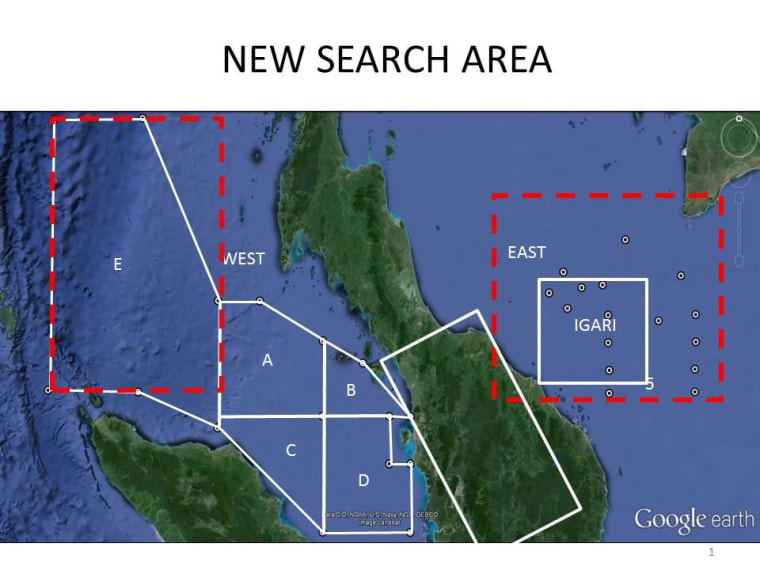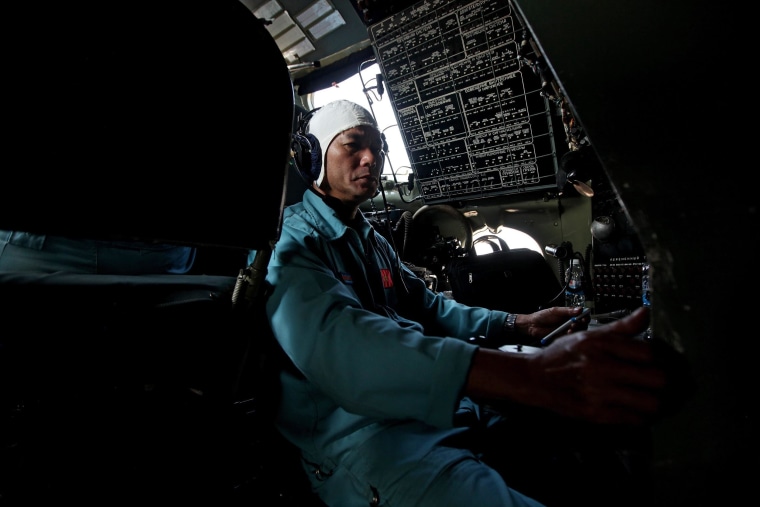With few clues, searchers are racing time, wind, and the current as they search for missing Malaysia Airlines Flight 370, which disappeared from radar early Saturday morning between Kuala Lampur and Vietnam with 239 people on board.
Even assuming that the wreckage landed in the water, searchers have hardly any solid hints to guide them.
“In other crashes, you might have good radar contact and see the altitude drop and drop until it crashes,” Commander Williams Marks told NBC News from the U.S.S. Blue Ridge in the South China Sea. “This one just kind of disappeared.”
Authorities and experts are not sure why the plane disappeared from radar. Regardless, it makes it more difficult to establish the starting point for a search, which is why Marks and the U.S. Seventh Fleet, coordinating with the Malaysian government and other national governments, is combing two areas: a sector in the Gulf of Thailand, where the ship was last spotted on radar, and the Strait of Malacca, where the plane might have turned around.
From there, search-and-rescue teams are competing against time and nature. The two biggest factors complicating the search are the wind and the currents.
The current in the Gulf of Thailand was moving at about one nautical mile per hour, according to the most recent scientific models on Monday.
At that rate, Marks noted, the search radius is increasing by at least one nautical mile per hour, meaning in a single day the search radius could expand by at least 24 nautical miles, or just under 28 land miles. Wind can make the situation even worse.

Right now, teams from the United States, Malaysia, Thailand, Australia and other countries are searching an area in the Gulf of Thailand that is 100 nautical miles across.
Compounding the problem is the fact that water renders a lot of technology useless.
“I think what most people don’t understand is once you get below the water, GPS doesn’t work,” David Gallo, director of special projects at the Woods Hole Oceanographic Institution, told NBC News. “You can’t use radio waves. Light doesn’t penetrate very far at all. All the things you would use to search on land, you don’t have beneath the sea.”
The U.S. Navy is currently using four MH-60R Seahawk helicopters and one P-3 Orion aircraft to look for physical evidence of the missing plane. Each helicopter, according to a release from the U.S. Seventh Fleet, is equipped with infrared cameras that allow it to search at night, while the P-3 can fly continuously for nine or 10 hours while searching the water with sensitive camera equipment.
Another factor is ocean depth. Judging by where the plane was last spotted, it could have landed in water deeper than 2,000 meters, or shallower than 100 meters, according to Arnold Gordon, head of ocean climate physics at the Lamont-Doherty Earth Observatory.
The latter would make it a lot easier to eventually recover the plane if it did go down in the water, he wrote to NBC News. The underwater terrain could also affect the ongoing search.
Gallo was co-leader of the search for Air France Flight 447, which plunged into the Atlantic Ocean in 2009. That plane, he said, went down over “an underwater mountain range that was as steep as the Rocky Mountains.”
The terrain off the coast of Malaysia, according to Gallo, is much gentler.
“That should make the search easier," he said, "but once you get out there and start looking, a plane is an awfully small object in an awfully big ocean."
The technological and logistical framework Malaysia has set up with surrounding countries to fight pirates in the region could be a big help, Thomas Anthony, a former regional investigator with the Federal Aviation Administration, told NBC News.
Ultimately, however, "there is no set time to call an investigation off," he said, pointing to the two years it took to discover the wreckage of Flight 447.
Robots were instrumental in finding the remains of that downed plane. They could be used again in this search. In the meantime, hundreds of human rescue workers are searching non-stop for answers to what happened to Malaysia Airlines Flight 370.
“There is a sense of pressure,” Marks, the U.S. Navy commander, said. “Time is not on our side. But this is what we trained for and we will do it for as long as we are needed.”
NBC News' Alan Boyle, Alastair Jamieson, and Matthew DeLuca contributed to this report.
